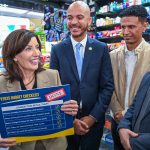
Changwon, South Korea
CNN
—
With a blinding yellow flash and a concussion that shakes bones, K9 self-propelled howitzers launch artillery shells onto a hill that’s just been hit by rockets fired from helicopters. Then K2 tanks roar in, speeding up roads and firing as they go.
This is part of DX Korea, a four-day South Korean defense expo held in September at a firing range in Pocheon, about 30 kilometers (18.6 miles) from the North Korean border.
The display – presented to a crowd of 2,000 people including military officials from more than two dozen countries – is one way South Korea sells weapons.
And President Yoon Suk Yeol wants to sell more of them – enough for Seoul to jump four places up the ranks to become the world’s fourth-biggest arms exporter.
“By entering the world’s top four defense exporters after the United States, Russia and France, the (South Korean) defense industry will become a strategic industrialization and a defense powerhouse,” Yoon said.
To do that, South Korea will have to outsell – in ascending order – the United Kingdom, Italy, Germany and finally China, which held 4.6% of the export market in the 2017-2021 period, according to the authoritative Stockholm International Peace Research Institute (SIPRI).
That’s no easy task, yet Seoul is already well on its way. From 2012 to 2016, it had just 1% of the global market. It more than doubled that in the following five-year period, capturing 2.8% – by far the largest increase among any of the world’s top 25 arms exporters.
In 2021, it sold $7 billion worth of weapons overseas, according to the Export-Import Bank of Korea.
And the South Korean defense industry believes it has the arsenal to grab an even bigger slice of the pie.
The push for self-reliance
South Korea’s weapons exports have ballooned in recent years, but the country has been building its arms industry for decades, spurred on by its troubled relationship with its northern neighbor.
As of 2020, military expenditures represented 2.8% of South Korea’s gross domestic product, according to SIPRI, well above the 2% threshold considered a minimum by many US allies.
“The North Korean threat has given us a good reason, a motivation to make sure that our weapons are very good,” says Chun In-bum, a former lieutenant general in the South Korean Army.
Technically, the Korean War never ended, because the document that stopped the combat in 1953 was an armistice, not a peace treaty.
In the first decades after the fighting ended, South Korea’s defense was heavily dependent on American troops and weaponry.
Things began to change in the 1970s, when the US was distracted by the war in Vietnam and the Cold War with the Soviet Union.
South Korea began to take more responsibility for its own defense and invested $42 million in US military aid in factories to produce M-16 rifles, according to the Korea Development Institute (KDI).
By the end of the decade, Korean researchers under the direction of the country’s National Defense Science Institute had succeeded in making all basic weaponry, according to a 2014 KDI report.
With the ever-present threats from the North, Seoul initiated a National Defense Tax to pay for the development of a modern military, including the armored systems and other military equipment that Korean defense companies are marketing today.
Weapons and Ukraine
Back on the hillside after the live-fire demonstration, prospective customers listened intently to the pitches of the South Korean representatives.
Delegations had arrived from as far afield as Mexico, Thailand, Nigeria and the Philippines. An Indian general asked for the ranges of a weapon on display. Qatari officers inspected a K2 up close.
Conspicuously, none of the potential customers were from Ukraine.
But that doesn’t mean South Korea’s arms industry isn’t seeing a role in Ukraine’s war with Russia.
A US defense official told CNN this month that Washington intends to buy 100,000 rounds of artillery ammunition from South Korean arms manufacturers to provide to Ukraine.
The rounds will be transferred to Ukraine via the US, allowing Seoul to stick to its public pledge that it would not send lethal aid to the war-torn country.
In a statement issued after the planned purchase was first revealed in The Wall Street Journal, the South Korean Defense Ministry said it had not changed its position on shipping weapons to Ukraine, and that it believed the “end user” of the ammunition was the US.
Russian President Vladimir Putin had said late last month that South Korea had decided to send “arms and ammunition” to Kyiv, which would “ruin our relations” with them – a claim denied a day later by President Yoon.
A South Korean presidential decree that enforces the country’s Foreign Trade Act says its exports can only be used for “peaceful purposes” and “shall not affect international peace, safety maintenance, and national security.”
South Korea is also a signatory to the United Nations’ Arms Trade Treaty, ratified in 2014 with the intention of keeping close control on who gets weapons and under what conditions they can be used. Ukraine is a signatory but hasn’t ratified it.
But the planned US ammunition transfer isn’t the only way the influence of South Korea’s arms industry will be felt in Ukraine.
In September, South Korea signed a deal with Poland for its biggest arms sale ever, in which it will supply Warsaw with almost 1,000 of Hyundai Rotem’s K2 tanks, more than 600 of Hanwha’s K9s, and dozens of fighter jets from Korean Aerospace Industries.
The deal will enable Poland to replace many of the weapons that Warsaw has sent to Kyiv.
“Poland needed weapons to defend themselves, and that’s exactly what we’re providing,” Chun says. “We Koreans understand that without weapons to defend yourself, the end result is a tragedy.”
A city designed with defense in mind
The constant threat of a North Korean attack is one reason military production lines were established in the southern port city of Changwon, the cradle of South Korea’s modern arms industry.
The city is in a natural basin, surrounded by mountains on all sides, making it easier to defend. The city’s main road, Changwon-daero, has a 14.9-kilometer (9.25-mile) stretch that can double as a runway in times of national emergency.
At its southern end is the Changwon National Industrial Complex, established in the 1970s and home to the Hanwha Defense and Hyundai Rotem factories, where artillery pieces and tanks trundle off the assembly lines.
Overseas orders are rolling in this year, notably the landmark deal with Poland which the Korea Defense Industry Association estimates to be worth $15.3 billion.
Hanwha puts its share of that agreement at $2.4 billion, its largest contract for the K9.
Poland is one of nine countries – alongside South Korea, Turkey, Finland, India, Norway, Estonia, Australia and Egypt – to buy the howitzer from Hanwha.
Lee Boo-hwan, an executive vice president of Hanwha Defense’s overseas business division, says the company wants to be a long-term partner to countries that buy its weapons. To that end, it is setting up new manufacturing facilities in Australia, Egypt and Poland.
“My workers are very happy to share our technology,” Lee says. “It is our main strategic focus to enter (new) markets.”
It’s also about continuously updating and improving the product, he says, and that’s happening inside South Korea.
The company has already prototyped the K9A2 tank, which situates the crew outside the turret to make them less vulnerable to attack, and is developing “a more futuristic, next generation version,” Lee says.
“It is fully automated operation, unmanned platform,” with artificial intelligence to let it learn on the battlefield, he says.
Rise of the robots
At a sprawling, modern complex in Changwon, Hanwha’s robots churn out the artillery pieces for K9s at the rate of one unit every three to five days.
A combination of robots and humans combine on a seven-station assembly line to put together what will eventually be 47 metric tons of steel, machinery and electronics.
One robot, more than two stories high, welds the turrets, the brightness of the white-hot procedure lighting up the cavernous assembly building.
Further down the line, another robot bores holes in the green-painted steel, switching bits automatically as it goes about its work with an accuracy of 1/100th of a millimeter, thinner than a human hair, according to a Hanwha Defense official.
Once the robots are done, it is the turn of Hanwha’s workers. Each hull as it goes along the line bears the pictures of 11 of them.
“We provide excellence by name,” says Lee, the Hanwha executive vice president.
At each assembly station, there’s a “tollgate,” with green, yellow and red lights. Any worker can stop the line with a red light and summon engineers if they spot a problem.
At the final stop is the bore sighting, where the accuracy of the K9’s gun is tested on a target at the far end of the workspace.
The completed units then go outside for performance testing, causing the ground to vibrate as they roar along a paved road near their top speed of 67 kilometers per hour (42 mph).
Test drivers spin the tracked howitzer one way then the other, the rubber pads on the tracks leaving donuts on the concrete.
As the drivers put the units through their paces, Lee explains how Hanwha customizes K9s for its overseas customers: those bound for northern climates like Norway get extra heat sources for the crew; those made for hotter places like India or Egypt get more air conditioning. Some of the factory’s K9s are headed for Poland this year.
Jack Watling, senior research fellow for land warfare at the Royal United Services Institute in London, says South Korea is the perfect testing ground.
Its seasons range from deep-freeze winters to monsoons and summer heat of 30 degrees Celsius or higher – and it has both flat and mountainous terrain.
“That is a pretty unique set of complex variables in terms of having a vehicle that’s reliable across climatic conditions,” Watling says.
And that’s attracted foreign buyers, he says.
Just a few miles from where the K9 artillery pieces are being tested, the K2 tanks at the Hyundai Rotem factory are being put through their paces.
Again, the latest customer is Poland.
“This is our first time directly exporting our (K2),” says Kim, the Hyundai Rotem VP.
Orders from South Korea’s military keep the K2 assembly line busy enough – but the Polish order means Hyundai Rotem can add capacity.
This is essentially like buying a new car off the lot. In the tank world, you can’t quite drive your new K2 home that day, but you get the idea.
“The most important thing is that it is currently being produced,” Kim says.
The important US market
Hanwha Defense has its eyes on one market in particular – the United States, the world’s largest defense market.
“We want to enter the US market with support from a US local company and also, we want to contribute to the US Army and the US local defense industry,” says Lee, the Hanwha VP.
In 2021, US military spending was $801 billion. But South Korean weapons and ammunition exports to the US accounted for only $95 million, according to the US Commerce Department.
Overall, US military spending was more than the next nine countries combined, according to SIPRI. South Korea ranked 10th.
But the South Korean defense industry should be seen as a partner that complements its American counterpart, rather than competes with it, Chun says.
That massive US military budget includes huge expenditure on top-shelf items. That’s not what Seoul is selling, he points out.
“There are portions of a spectrum of weapons that the United States does not make, because they feel they don’t need to. It doesn’t make a profit for their industry. That’s what we’re targeting. The systems that we have sold to Poland are exactly those kind of systems,” he says.
“I’m hoping that the United States understands that this is a partnership,” Chun adds.
“The United States makes the greatest and best weapons in the world,” he says, “but they don’t make all of them.”
CNN’s Oren Liebermann contributed to this report.





